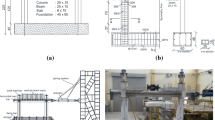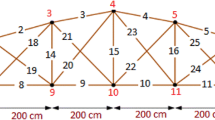Abstract
A general method is formulated to estimate damage location and extent from the explicit perturbation terms in specific set of eigenvectors and eigenvalues. At first, perturbed orthonormal equation is generated from the perturbation of eigenvectors and eigenvalues to obtain the k-th explicit perturbation coefficients. At second, perturbed eigenvalue equation is generated from the perturbation of eigenvector and eigenvalue, and first-order expansion of the stiffness matrix to obtain other explicit perturbation coefficients. Stiffness parameters are computed from these equations using an optimization method. The algorithm is iterative and terminates under certain criteria. A fixed–fixed modular beam with various numbers of elements is used as test structure to investigate the applicability of the developed approach. By comparison with the Euler–Bernoulli beam, discretization errors are analyzed. In six elements beam, first-order algorithm converges faster for small percentage damage. Second-order algorithm is more efficient for medium percentage damage. For large percentage damage, the second-order algorithm converges more effectively. Meanwhile, for eight elements large percentage damage and ten elements small percentage damage, second-order algorithm converges faster to the termination criterion.
Similar content being viewed by others
References
Rayleigh B.: The theory of sound, vol. 1, pp. 214–217. Dover, New York (1945)
Wilkenson J.H.: The algebraic eigenvalue problem. Clarendon Press, Oxford (1965)
Bellman R.: Introduction to matrix analysis, 2nd edn, pp. 60–63. McGraw-Hill Book Co, New York (1970)
Romstad K.M., Hutchinson J.R., Runge K.H.: Design parameter variation and structural response. Int. J. Num. Methods Eng. 5, 337–349 (1973)
Stetson K.A.: Perturbation method of structural design relevant to holographic vibration analysis. AIAA J. 13, 457–459 (1975)
Meirovitch L., Ryland G.: A perturbation technique for gyroscopic systems with small internal and external damping. J. Sound Vib. 100(3), 393–408 (1985)
Meirovitch L., Ryland G.: Response of lightly damped gyroscopic systems. J. Sound Vib. 67, 1–19 (1979)
Jones R.P.N.: The effect of small changes in mass and stiffness on the natural frequencies and modes of vibrating systems. Int. J. Mech. Sci. 1, 350–355 (1980)
Wong C.N., Zhu W.D., Xu G.Y.: On an iterative general-order perturbation method for multiple structural damage detection. J. Sound Vib. 273(1–2), 363–386 (2004)
Wong, C.N., Chen, J.C., To, W.M.: Eigenparameter perturbation method for structural damage detection. 37th AIAA/ASME/ASCE/AHSASC Structural Forum, Salt Lake City UT, 76-ASF-9:658–667 (1996)
Wong C.N., Chen J.C., To W.M.: Model updating of a suspension bridge model using parametric perturbation method. Proceedings of Asia-Pacific Vibration Conference ‘95, Kuala Lumpur, Malaysia 2, 241–246 (1995)
Chen S.H.: Matrix perturbation method of degenerate vibration systems. J. Jilin Univ. Technol. 4, 11–15 (1981)
Hu H.C.: Natural vibration theory of multi-degree-of-freedom structures, pp. 17–24. China Science Press, Beijing (1987)
Chen S.H., Liu Z.S., Shao C.S., Zhao Y.Q.: Perturbation analysis of vibration modes with close frequencies. Commun. Num. Methods Eng. 9, 427–438 (1993)
Wanxie Z., Gengdong C.: Second-order sensitivity analysis of multimodal eigenvalues and related optimization techniques. Mech. Based Des. Struct. Mach. 14(4), 421–436 (1986)
Wicher J., Nalecz A.G.: Second order sensitivity analysis of lumped mechanical systems in the frequency domain. Int. J. Num. Methods Eng. 24, 2357–2366 (1987)
Ryland G. II, Meirovitch L.: Response of vibrating systems with perturbed parameters. J. Guid. Control 3(4), 125–131 (1980)
Kan C.L., Chopra A.K.: Elastic earthquake analysis of torsionally coupled multistorey buildings. Earthq. Eng. Struct. Dyn. 5(4), 395–412 (1977)
Hejal R., Chopra A.K.: Elastic earthquake analysis of a class of torsionally coupled buildings. Earthq. Eng. Struct. Dyn. 18(3), 305–323 (1989)
Tsicnias T.G., Hutchinson G.L.: A note on the perturbation analysis of the mode shapes of torsionally coupled buildings. Earthq. Eng. Struct. Dyn. 10(1), 171–174 (1982)
Zhu, W.D., Wong, C.N., Xu, G.Y.: Iterative method to detect structural damage using vibration characteristics. Baltimore Gas and Electric Corporation. Technical report 10-2003 (2003)
Patalambros P.Y., Wilde D.J.: Principles of optimal design—modeling and computation, pp. 338–343. 2nd edn. Cambridge University Press, New York (2000)
Author information
Authors and Affiliations
Corresponding author
Rights and permissions
About this article
Cite this article
Wong, C.N., Huang, HZ., Xiong, J. et al. Generalized-order perturbation with explicit coefficient for damage detection of modular beam. Arch Appl Mech 81, 451–472 (2011). https://doi.org/10.1007/s00419-010-0421-z
Received:
Accepted:
Published:
Issue Date:
DOI: https://doi.org/10.1007/s00419-010-0421-z




